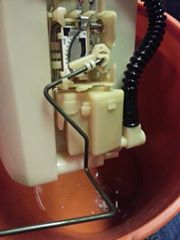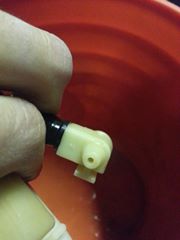There's something wrong with my fuel pressure regulator.....
Roughly 95% of the fuel pressure regulators we sell are for a return style fuel system, so that’s what I’m going to focus on for this tech article. This is a tech call that I field at least 5 times each week.
By design, there’s really only one thing that can fail on a regulator, and it's pretty rare. Occasionally a diaphragm does fail. When this happens, you will experience fuel leaking out of the boost reference port. That can be caused by any number of things, but it’s usually debris in the fuel causing a small tear of some kind or a fuel additive that is not compatible with the diaphragm material.
Switching regulator brands isn’t going to fix this compatibility problem because pretty much all of the main regulator manufacturers use the same diaphragm material. If you don’t experience a fuel leak at the boost reference port, chances are your regulator is not the problem. The problem is either on the feed side or the return side (before or after the regulator).
“I can’t get my fuel pressure down low enough…..” Fuel pressure regulators are nothing more than a restriction in the fuel line - like your thumb over the end of the garden hose. The harder you press your thumb down, the higher the pressure in the hose (your fuel line) gets before the water sprays out (your return line).
If you have fuel pressure that is too high, there’s one of two problems. You either have a regulator that is undersized for your application or you have a restriction in the return line. Our regulators come in a number of different configurations. One of the main differences is the size of the return seat/orifice. The return seat size is more or less what decides how much fuel the regulator can bypass (return).
If you have a rather large pump(s), but you’re trying to use our mini regulator, you’re going to experience an issue where you can’t get your pressure down low enough. The return orifice of the regulator is simply too small to bypass enough fuel to keep the pressure down. If this is the case, you need to switch to a regulator that matches your flow needs.
The other potential problem is a restriction in the return line (usually the issue). This can be caused by several things - the return line size is too small, drilled 90* fittings/sharp bends, restrictive fittings inside a factory fuel pump module, etc. Restrictions after the regulator are pretty much the same as an undersized regulator. You might have a regulator that can bypass enough fuel, but the restriction in the return line doesn’t allow the fuel to flow freely back to the fuel tank.
The two most common return line restrictions are the use of cheap 90* drilled fittings or something in the factory fuel pump module that the customer is trying to feed into. Many customers will try to re-use a factory line for the return line. Assuming the line size is up to the challenge, there's nothing wrong with that. However, they don’t always pay attention to the flow path once the line enters the fuel pump module - they assume it’s just dumping right into the tank. A good example is a customer I recently worked with. His particular setup seemed correct…. on the surface. He had a pump and regulator that was matched correctly and the plumbing sizing and type of fittings sounded correct, yet he couldn’t get his pressure down low enough. After taking the factory fuel pump module out, he found the restriction. The line he was using was -6, yet there was a factory fitting in the fuel pump module just before the fuel entered the tank that had an opening of only 5/64” (see photos below). While that may be enough for a factory pump, it’s nowhere near enough for a larger aftermarket pump. He doubled the size of the opening (thus allowing nearly 4x the flow) and the fuel pressure problems were gone. In short - if your fuel pressure is too high, find the bottleneck in the return side of your fuel system and remove it.



The black flex hose is the factory return line on this particular car. That little orifice is NOT going to let fuel flow freely back into the tank. Drilling out the plastic fitting cured the high fuel pressure problems this customer was experiencing. “I can’t get my fuel pressure high enough…..” If you are experiencing this issue, it’s most likely a supply problem. This is caused by a weak or undersized pump.
Pumps are only capable of building so much pressure - some pumps more than others. An example being someone trying to use a pump that was meant for a carbureted application in an EFI car. Most pumps for a carbureted application were built with the intent of never seeing high pressure. You shouldn’t expect a low pressure pump to be able to build EFI pressure.
Pump wear can also play a part in the inability to build high enough pressure. A worn pump will have more internal leakage, thus lower pressure. Even EFI pumps have their high pressure limitations. They might be able to build high pressure, but they are unable to maintain the pressure while still flowing enough to keep up with the needs of the engine. An example of this is a car that maintains the target pressure at idle and cruising, but experiences fuel pressure drop under high demands. This is simply a case of an undersized pump and you need to look at getting something that will flow more. Take our 41401 pump and our 42402 pump for example. Both are capable of building 100psi, but the 42402 pump is going to flow significantly more fuel and that pressure and will therefore support more power. In short- if your fuel pressure is dropping off, you’re running out of fuel. You need a bigger pump. At the beginning of this paragraph, I said “….it’s most likely a supply problem.” Although pretty rare, there is the off chance that a piece of debris is caught in the seat area of the regulator which is not allowing it to seal. That will more or less allow the regulator to bypass fuel before it reaches your target pressure. If you suspect this, either disassemble the regulator to inspect/clean the seat area or loosen the adjustment screw as much as possible, hoping to flush the debris out and into the return line (not ideal, but could work in a pinch).
The key to good/consistent fuel pressure and flow is this: Buy a pump that will flow a little more than your engine needs, remove as many inlet restrictions on the pump as possible, match it to a regulator that is compatible with the flow of the pump, and remove as many return line restrictions as possible.

You must login to post comments.